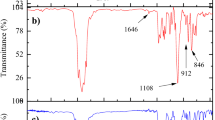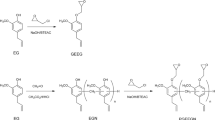Abstract
This article reports the synthesis of a bio-inspired curing agent, the tetraallyl cystamine (TAC) and the evaluation of its performance to photocure two epoxy resins derived from the terpenoid nopol, by using the epoxy/thiol-ene photopolymerization technique. The curing agent was prepared in two stages: a) reaction of the diallylamine with ethylene disulfide, through a mercaptoethylation reaction and b) oxidation of the obtained thiol to disulfide, using dimethylsulfoxide as an oxidizing agent. To the epoxy resins was added the curing agent TAC, pentaerythritol tetrakis (3-mercaptopropionate) and dimethoxyphenylacetophenone, to obtain cross-linked co-networks of the polyether-polythioether type. A trifunctional nopol epoxycycloaliphatic epoxy resin and an epoxycycloaliphatic-glycidyl nopol epoxy resin were evaluated, with the former displaying higher reactivity, higher modulus and higher thermal stability.











Similar content being viewed by others
References
Mika TF, Bauer RS (1988) Curing agents and modifiers, in Epoxy Resin Chemistry, ed C. May, CRC Press, Boca Raton, USA
Ding C, Matharu AS (2014) Recent Developments on Biobased Curing Agents: A Review of Their Preparation and Use. ACS Sust Chem & Eng 2:2217–2236
Mora AS, Tayouo R, Boutevin B, David G, Caillol S (2019) Synthesis of biobased reactive hydroxyl amines by amination reaction of cardanol-based epoxy monomers. Eur Polym J 118:429–436
Yang X, Wang C, Li S, Huang K, Li M, Mao W, Cao S, Xia J (2017) Study on the synthesis of bio-based epoxy curing agent derived from myrcene and castor oil and the properties of the cured products. RSC Adv 7:238
Thiele K, Eversmann N, Krombholz A, Pufky-Heinrich D (2019) Bio-Based Epoxy Resins Based on Linseed Oil Cured with Naturally Occurring Acids. Polymers 11:1409
Altuna FI, Pettarin V, Williams RJ (2013) Self-healable polymer networks based on the cross-linking of epoxidised soybean oil by an aqueous citric acid solution. Green Chem 15:3360–3366
Tudorachi N, Mustata F (2020) Curing and thermal degradation of diglycidyl ether of bisphenol A epoxy resin crosslinked with natural hydroxy acids as environmentally friendly hardeners, Arab. J Chem 13:671–682
Wang H, Wang H, Zhou G (2011) Synthesis of rosin-based imidoamine-type curing agents and curing behavior with epoxy resin. Polym Int 60:557–563
Liu X, Xin W, Zhang J (2009) Rosin-based acid anhydrides as alternatives to petrochemical curing agents. Green Chem 11:1018–1025
Su WC, Tsai FC, Huang CF, Dai L, Kuo SK (2019) Flexible epoxy resins formed by blending with the diblock copolymer PEO-b-PCL and using a hydrogen-bonding benzoxazine as the curing agent. Polymers 11:201
Feng X, Fan J, Li A, Li G (2020) Biobased Tannic Acid Cross-Linked Epoxy Thermosets with Hierarchical Molecular Structure and Tunable Properties: Damping. Shape Memory, and Recyclability, ACS Sust Chem & Eng 8:874–883
Huang Y, Ma T, Wang Q, Guo C (2019) Synthesis of biobased flame-retardant carboxylic acid curing agent. ACS Sust Chem & Eng 7:14727–14738
Chang R, Qin J, Gao J (2014) Fully biobased epoxy from isosorbide diglycidyl ether cured by biobased curing agents with enhanced properties. J Polym Res 21:501
Stemmelen M, Pessel F, Lapinte V, Caillol S, Habas JP, Robin JJ (2011) Fully Biobased Epoxy Resin from Vegetable Oils: From the Synthesis of the Precursors by Thiol-ene Reaction to the Study of the Final Material. J Polym Sci Part: A 49:2434–2444
Jaillet F, Desroches M, Auvergne R, Boutevin B, Caillol S (2013) New Biobased Carboxylic Acids Hardeners for Epoxy Resins. Eur J Lipid Sci Technol 115:698–708
Acosta Ortiz R, Garcia Valdez AE, Navarro Tovar AG, Hilario de la Cruz AA, Gonzalez Sanchez LF, Trejo Garcia JH, Espinoza Muñoz JF, Sangermano M (2014) Development of an hybrid epoxy-amine/thiol-ene photocurable system. J Polym Res 21:504
Sangermano M, Roppolo I, Acosta Ortiz R, Garcia Valdez AE, Navarro Tovar AG, Berlanga Duarte ML (2015) Interpenetrated hybrid thiol-ene/epoxy UV-cured network with enhanced impact resistance. Prog Org Coat 78:244–248
Acosta Ortiz R, Garcıa Valdez AE (2016) Synthesis, Reactivity and Mechanical Properties of Photocurable Epoxy-Thiol-ene Systems, in Epoxy resins: Synthesis, Applications and Recent Developments, ed. M. Cain, Nova Publishers, New York
Acosta Ortiz R, Garcıa Valdez AE, Sangermano M, Hilario de la Cruz AA, Aguirre Flores R, Espinoza Munoz JF (2015) Comparison of the Performance of Two Bifunctional Curing Agents for the Photopolymerization of Epoxy Resins and the Study of the Mechanical Properties of the Obtained Polymers. Macromol Symp 358:35–40
Ellis B (1993) Chemistry and Technology of Epoxy Resins. Springer, Science and Businees Media, Dordrecht, NL
Cantwell WJ, Kausch HH (1993) Fracture behavior of epoxy resins in Chemistry and Technology of Epoxy Resins. Springer, Science and Businees Media, Dordrecht, NL
Unnikrishnan KP, Thachil ET (2006) Toughening of epoxy resins. Des Monom & Polym 9:129–152
Dusek K, Lednicky F, Lunak S, Mach M, Duskova D (1984) The toughening of epoxy resins with reactive polybutadienes, in Rubber-Modified Thermoset Resins, ed. K Riew and J.K. Gillham, vol 208, ACS Publications
Hodgkin JH, Simon GP, Varley RJ (1998) Thermoplastic toughening of epoxy resins: a critical review. Polym Adv Tech 9:3–10
Lee J, Yee AF (2001) Inorganic Particles Toughening II: Toughening mechanism of glass beads filled epoxies. Polymer 42:589–597
Huang CF, Chen WH, Aimi J, Huang YS, Venkatesan S, Chiang YW, Huang SH, Kuo SK, Chen T (2018) Synthesis of well-defined PCL-b-PnBA-PMMA. ABC triblock copolymers: towards the construction of nanostructures in epoxy thermosets, Polym, Chem 9:5644–5654
Sandler SR, Karo W (2012) Epoxy Resins in Polymer Syntesis, 2nd ed., vol 2, 87–128, Academic Press
Acosta Ortiz R, Garcia Valdez AE, Soria Arguello G, Mendez Padilla MG, Acosta Berlanga O (2018) Photocurable Shape-Memory Polyether-Polythioether/Graphene Nanocomposites and the study of their thermal conductivity. J Polym Res 25:160
Acosta Ortiz R, Acosta Berlanga O, Garcia Valdez AE, Aguirre Flores R, Tellez Padilla G, Mendez Padilla MG (2016) Self-healing Photocurable epoxy/thiol-ene systems using an aromatic epoxy resin, Advances in Material Science and Engineering; Article ID 8245972. https://doi.org/10.1155/2016/8245972
Acosta Ortiz R, García Valdez AE, Rodriguez Ramos ZY, Acosta Berlanga O, Aguirre Flores R, Méndez Padilla MG, Espinoza Muñoz JF (2017) Development of rigid toughened photocurable epoxy foams. J Polym Res 24:110
Acosta Ortiz R, Garcıa Valdez AE, Garcia Padilla EE, Aguirre Flores R, Espinoza Munoz JF (2016) Development of a photocurable glass-fiber reinforced epoxy-amine/thiol-ene composite. J Polym Res 23:30
Acosta Ortiz R, Ku Herrera JJ, García Santos AO, García Valdez AE, Soria Arguello G (2021) Tensile Strength and Fracture Mode I Toughness of Photocurable Carbon Fiber/Polyether-Polythioether Composites. J Polym Res 28:46
Acosta Ortiz R, García Valdez AE, Ku Herrera JJ (2020) Simultaneous reduction in situ and thiol- functionalization of Graphene Oxide during the Photopolymerization of Epoxy/Thiol-ene photocurable systems to prepare polyether-polythioether/reduced graphene oxide nanocomposites. Polym Plast Tech & Mat 59:282–293
Acosta Ortiz R, García Valdez AE, Hernández Cruz D, Nestoso Jiménez G, Hernández Jiménez AI, Téllez Padilla JG, Guerrero Santos R (2020) Highly Reactive Novel Biobased Cycloaliphatic Epoxy Resins Derived from Nopol and a Study of Their Cationic Photopolymerization. J Polym Res 27:144
Bettanin L, Saba S, Galetto FZ, Mike GA, Rafique J, Braga AL (2017) Solvent- and metal-free selective oxidation of thiols to disulfides using I2/DMSO catalytic system. Tetrahedron Lett 58:4713–4716
Rajamaran SK, Mowers WA, Crivello JV (1999) Interaction of epoxy and vinyl ethers during photoinitiated cationic polymerization. J Polym Sci: Part A: Polym Chem 37:4007–4018
Hoyle CE, Lee TY, Roper T (2004) Thiol-enes: Chemistry of the past with promise for the future. J Polym Chem Part A: Polym Chem 42:5301–5338
Acknowledgements
The support of the Mexican National Council of Science and Technology (CONACYT) through grant 282882 (Fundamental Science) is greatly appreciated. We gratefully acknowledge María Guadalupe Méndez, Myrna Salinas, José Guadalupe Tellez, Jorge Felix Espinoza, and Judith Cabello for their assistance regarding the study analysis
Author information
Authors and Affiliations
Corresponding author
Ethics declarations
Conflict of interest
We declare that this manuscript contains data resulting from original research and has not been submitted elsewhere. There are no conflict of interest in publishing the results of this study.
Additional information
Publisher's Note
Springer Nature remains neutral with regard to jurisdictional claims in published maps and institutional affiliations.
Rights and permissions
About this article
Cite this article
Acosta Ortiz, R., Hernández Jiménez, A.I. & García Valdez, A.E. Synthesis of tetraallylated cystamine and the study of its performance as a curing agent for the epoxy/thiol-ene photopolymerization of biobased nopol epoxy resins. J Polym Res 28, 366 (2021). https://doi.org/10.1007/s10965-021-02725-5
Received:
Accepted:
Published:
DOI: https://doi.org/10.1007/s10965-021-02725-5




